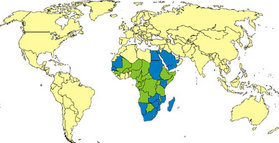On September 17, 2000, the Ministry of Agriculture and Irrigation (MAI) and Ministry of Health (MOH) of Yemen received reports about the occurrence of disease compatible with Rift Valley fever (RVF) in El Zuhrah district of Hodeidah governorate. Reports of animal disease included abortions and deaths in young animals. Surveillance efforts by MOH and MAI documented widespread disease among humans and animals in the area of Wadi Mawr in El Zuhrah district, which is located on a coastal plain that extends from the southern tip of Yemen into the Jizan area of the Kingdom of Saudi Arabia (KSA). The Saudi Arabian Ministry of Health has described a simultaneous outbreak of RVF in the Jizan area in KSA [1,2]. This report summarizes the investigation of the Yemen outbreak.
MAI and MOH responded to the epidemic by organizing a national effort to limit spread of disease, optimize management of affected persons, and track the course of the outbreak. The World Health Organization (WHO) provided technical assistance, including experts in virology, epidemiology, laboratory diagnostics, and entomology.
Disease in humans. Because most patients in the outbreak area do not seek health care in medical facilities, mobile surveillance teams traveled to villages to interview case-patients or animal owners about recent illness in the community. Initial case finding was focused among villages in Wadi Mawr and was expanded to include areas throughout the coastal plain. The WHO case definition for disease in humans was used [3]. During August 7-November 7, 2000, 1087 suspected case-patients were identified, including 121 (11%) persons who died. The mean age of suspected case-patients was 32.2 years (range: 1 month-95 years). The clinical spectrum of disease was typical of that associated with RVF and includes patients with hemorrhagic disease, encephalitis, retinitis, and uncomplicated RVF. Of the 1087, 815 (75%) case-patients reported exposure to sick animals, handling an abortus, or slaughtering animals in the week before onset of illness. Of 490 case-patients with serologic testing, 136 (26%) had IgM-class antibod y to RVF virus; 17 (3%) patients had weakly reactive serologic test results. Serologically confirmed disease transmission was detected in 15 districts throughout the coastal plain and adjacent mountains.
Disease in animals. To assess the extent of transmission in animals, cross-sectional surveys were conducted in late September in diverse areas throughout Yemen. These surveys detected a high prevalence of IgM-class antibody to RVF in numerous areas in the northern part of the coastal plain and adjacent mountains. Little evidence exists of RVF transmission south of Marawah. Since that time, transmission has been detected in animals and humans in areas to the south.
Reported by: AAW Nasher, MD, AK Shiban, MD, M Al Erlyani, MD, A Aly Bourgy, MD, AH AI Kohlani, MD, M Benbrake, MD, S El Mktary, MD, K AI Selwy MD, AA Kader, MD, MD Abby, MPH, GG Amran, MD, D El Wasaby, A Zabarah, A Sabet, M Azy, M Header, HR Header, M El Hady Amin, YA Wareth, MD, M Ramadany, Yemen Ministry of Health; AS AI Gabali, AM AI-Arashi, G AI Ariyani, DVM, N AI Hamadi, DVM, H AI-Fosail, DVM, M AI Qadasi, DVM, K Said, DVM, A Hadi, DVM, Yemen Ministry of Agriculture and Irrigation; A AI-Jouffi, Sanaa Medical Univ, Sanaa, Yemen. Food and Agriculture Organization, United Nations. AT Ba Omer, S AI-Busaidi, MD, S Ismalili, DVM, AA AI Sohby, DVM, SI Mash Hady, AA Ghalil Shabana, K AI-Salmi, Oman Ministry of Health. HA EI-Zein, MD, M Aly Khalifa, MD, F EI-Samani, MD, Z Hallaj, MD, D Klauke, MD, World Health Organization. AA EI-Kholy, MD, IM Ibrahim, MD, W Naguib, MD, Field Epidemiology Training Program, Arab Republic of Egypt. D Salman, DVM, S Lewis, PhD, E Dykstra, PhD, H EI-Sakka, MD, R Graham, DVM, F Mahone y, MD, US Naval Medical Research Unit No. 3.
Editorial Note: The outbreak described in this report coincides with an ongoing outbreak of RVF in KSA that together represent the first documented evidence of RVF virus transmission outside Africa. RNA sequencing of the virus from KSA indicates that it is similar to the RVF viruses isolated from East Africa in 1998 [1].
It is unclear whether there was a recent introduction of RVF virus into the Arabian peninsula or the emergence of an epidemic resulting from unique ecologic conditions. RVF virus may have been introduced into Yemen in 1998 and environmental factors may be promoting wide-scale disease occurrence.
Satellite images and aerial surveys reveal numerous areas throughout the coastal plain and adjacent mountains that would be conducive for transmission of RVF virus. The geographic distribution of disease hampered surveillance efforts and presents a challenge for disease-control efforts. Outbreak-control measures included vector-control (i.e., outdoor and indoor thermal fogging and larviciding and residual house spraying), restricting animal movement, preventing exposure to infected animals or abortuses through educational campaigns, and upgrading local hospitals to optimize treatment of infected patients. Entomologic studies are ongoing to evaluate and guide vector-control operations. Impregnated mosquito bed nets also have been distributed in the affected areas.
Despite intensive vector-control measures, transmission continues to occur in selected areas. The finding that most patients had direct contact with infected animals emphasizes the importance of health education to prevent transmission through this route. Cross-sectional surveys are ongoing to evaluate the severity of disease and to target and evaluate control efforts.
References
(1.) CDC. Outbreak of Rift Valley fever--Saudi Arabia, August--October, 2000. MMWR 2000;49:905-8.
(2.) CDC. Update: outbreak of Rift Valley fever--Saudi Arabia, August--November, 2000. MMWR 2000;49:982-5.
(3.) World Health Organization. WHO recommended surveillance standards. Geneva, Switzerland: World Health Organization, 1999.
COPYRIGHT 2000 U.S. Government Printing Office
COPYRIGHT 2004 Gale Group



